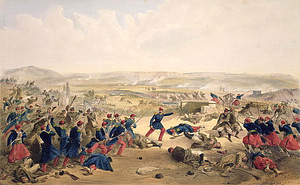|
Battle of the Chernaya
The Battle of the Chernaya (also Tchernaïa; Russian: Сражение у Черной речки, Сражение у реки Черной, literally: Battle of the Black River) was fought near to the Chernaya River during the Crimean War on August 16, 1855. The battle was fought between Russian, French, Piedmontese and Ottoman troops. The Chernaya River is on the outskirts of Sevastopol, near the line of the allies' siege of the city. The battle ended in a Russian retreat and a victory for the French, Piedmontese, and Ottomans. PlanningThe battle was planned as an offensive by the Russians with the aim of forcing the Allied forces (French, British, Piedmontese, and Ottoman[7]) to retreat and abandon their siege of Sevastopol. Tsar Alexander II had ordered his commander in chief in the Crimea, Prince Michael Gorchakov to attack the besieging forces before they were reinforced further.
The battle  58,000 Russian troops in two army corps under Prince Michael Gorchakov fought against 36,000 French and Sardinian troops under French General Aimable Pélissier and Piedmontese General Alfonso Ferrero La Marmora. Ottoman forces—six battalions of infantry and one artillery battery—were commanded by Władysław Kościelski [(Ottoman name "Sefer Pasha").[9] Although the British correspondents were amazed at the courageousness and impetuosity of the Russian attack,[10] the assault was handicapped by poor organization and lack of experienced soldiers which, due to Sevastopol, forced their corps to consist mostly of militia. In the cover of the morning fog, the Russians advanced towards Traktir Bridge with 47,000 infantry, 10,000 cavalry and 270 cannon under command of General Pavel Liprandi on the left and General Nikolay Read on the right. The two generals had been ordered by Gorchakov not to cross the river until given explicit orders. Annoyed that things weren’t happening fast enough, Gorchakov sent a note to his generals with the words "Let's start it." By this, Gorchakov only meant that the Russians should start to deploy their forces. His generals interpreted his words as his order to attack and they acted accordingly, although reserve forces were still en route to the battlefield.[11]  The attacking Russians immediately met stiff resistance from the French and Sardinians. Read's forces crossed the river near the Traktir Bridge but without cavalry and artillery support, they were easily stopped by the French on the Fedyukhin Heights (Федюхины высоты). Read then ordered his reserve formation, the 5th Infantry Division, to attack the Heights but instead of launching a coordinated assault, he fed them piecemeal into the fray. Going in regiment by regiment, the assaulting reserve troops accomplished nothing. Seeing this, Gorchakov ordered Read to deploy the entire division against the French. This forced the French back up the hill but the Russians could not capture the Heights. In the following retreat General Read was killed. Upon the death of Read, Gorchakov took personal command of the right and ordered 8 battalions of Liprandi's left wing to reinforce the right wing. These forces came under fire from the Sardinians and were driven back. At 10 o’clock in the morning, Gorchakov concluded that the situation was hopeless and ordered a general retreat.[12] The bravery of Sardinian troops and the French soldiers of the 50th, 82nd, 95th, 97th of the line; the 19th Foot Chasseurs; and the 2nd and 3rd Zouaves was especially noted. The Sardinian troops' valiant effort at the battle was a contributing factor to their inclusion at the negotiation tables at the end of the war; it was there that the Kingdom of Sardinia began looking for the aid of other European nations towards the Unification of Italy. TolstoyRussian Count Leo Tolstoy was a participant in the Battle of the Chernaya River. He witnessed as the Russians crossed the river and started up the hillside in the morning sunlight. Tolstoy saw Russian soldiers being killed in clusters as shells exploded around them. Before the morning was over, the Russians were forced to retreat. They left thousands of their dead comrades behind. Tolstoy was depressed and angered by the slaughter. He believed much of it was due to incompetent generals and staff. Tolstoy vented his anger by composing a satiric stanza, an approximate translation of which reads: The toppest brass
AftermathThe battle was a disaster for the Russians. Even with numerical superiority, the Russians had managed to lose the battle and suffer almost five times as many casualties as the Allies. Tsar Alexander had hoped for a Russian victory so that he could negotiate a peace with favorable terms. That hope was now lost. As a result of the slaughter that took place at the battle, the Russian soldiers had lost their trust in the Russian commanders and it was now only a question of time before the Russian army would be forced to surrender Sevastopol.[15][16] Citations
References
External links
|
||||||||||||||||||||||||||||||
